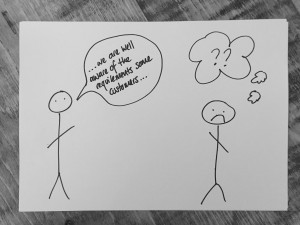If customers could see the world the way you do, imagine how much easier it would be to work with them. Here’s how to do it by humanising the way you interact with them and making things simpler.
Earlier last year I worked with a client’s technical team on the way they handled complaints, emails, social media and customer calls.
It was fascinating to watch – and listen to – them in action.
Like most technical people, they’re proper experts. Get them on Mastermind and they’d nail it. And that was exactly the problem.
Because they’re experts, they see all the valencies, the complications and the background to customers’ questions and complaints. They understand the depth of processes they need to go through to give a full answer. They also know how regulation works in their industry and the compliance hoops they have to jump through.
And, unsurprisingly, they explained all this to their customers. They wanted them to see that they cared and that they were doing their best to solve their problems.
But customers didn’t understand. Where the team thought they were giving customers useful information, customers thought they were being spun a line. In trying to make their replies comprehensive, they ended up just being too complex.
The result? More complaints, more kickback and more angry clients.
So how did we fix it? We talked about five things that would transform their responses to customers.
1. Remember what it’s like to be a customer, not an expert
This is a tough one because you can’t unknow what you know. But you can start by asking what the customer wants to know. They’re far more interested in the actions you’re going to take than the fact you’ve followed procedure. No need to go into War and Peace detail about it. Explain simply, talk about actions and results.
2. Kill jargon
Jargon is like pyjamas. Best not seen in public. It’s great internally because it saves you hours of time. But customers don’t understand it. Thing is, you probably won’t always know when you’re using it, so check with a colleague in a different team (or, ideally, someone outside) that you’re jargon-free.
3. Start with the big picture
If you’re in technical customer service, you’ll spend your life in the detail. Customers don’t – and won’t understand it. Start by giving them the big picture – the concepts – then add the detail once they understand. That’s assuming they even need the detail at all…
4. Remember people are emotional before they’re rational
We all kid ourselves that we’re rational beings who are emotional sometimes. In fact, every psychological study show’s we’re emotional beings who occasionally manage to be rational. We react emotionally before we respond rationally.
That means the emotional side of a response to a customer is not as important as the rational side – it’s MORE important.
5. Show you’ve listened
Customers don’t often get properly listened to. Customer teams are usually so busy trying to find a practical solution – and under a lot of time pressure – that just listening actively to customers gets forgotten. But it’s incredibly powerful. You’ll find that a lot of customers simply talk and talk and talk themselves out. By the time they’ve finished talking – and you’ve listened to them – the complaint goes away. Try it.
The results?
We cut the length of most of their standard, templated, technical emails by 50%. We objectively measured their readability and simplified them massively. We took a scalpel to the jargon and cut it out. We added emotion to the email templates – and to customer calls. We found ways for the team to sound more human and less corporate.
First contact resolutions have rocketed. Complaints that looked as though they’d escalate don’t anymore. Customers have started saying ‘thank you’ for the emails they get back (really). Customers are less aggressive on the phones. Calls are shorter and more human in tone.
The team are way less stressed and smile a lot. And so do the customers.





These words are so true! We sell insurance that helps people get their driver’s license reinstated and in their eyes they have been put through the ringer! Regardless of how they lost their license our customer service agents need to eliminate all judgement and treat the customers with respect. Some customers can be very rude but remembering it’s not personal is very important!